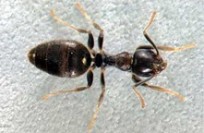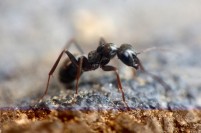Ants are eusocial insects (live in a cooperative group) and have colonized almost every landmass on Earth. In New Zealand there are 40 confirmed species of ants, of these 11 are native species. These species are generally widespread geographically and commonly found in forest habitats. The other 29 species found in New Zealand were introduced by mistake, mostly from Australia.
Ant societies are efficient when it comes to working together; they all have their set roles in the colony. The queen will spend most of her life laying eggs to create new workers in turn, growing the colony. When the larvae are ready to hatch the pupa will stay to look after the queen and feed the young larvae. Together with the adult workers, they decide what needs to be done; gather food and defend the nest.
There are two main species of ants that you will see around your home: Th white-footed house ant and black house ants.

White-footed House Ant |

Black House Ant |
The white-footed house ants are jet black in colour with pale legs around 3mm long. They form multi-nests and can have multi-queens. They are normally nocturnal and seem to favour kitchens and bathrooms. However, when it gets cold, they can also be found nesting in electrical appliances and circuit-boards, causing them to malfunction or destroying them completely. These white-footed house ants are attracted to sweet foods but will also eat dead insects, and nectar from shrubs.
Black house ants are fully black and about 2.5-3mm in size. These ants have a single nest with only one queen per colony. Normally their nests can be found under stones, in dry or fallen logs.Black house nests around the home, will typically be found against paths, stones, cracks, and crevices sometimes in wall cavities and roof voids. They mostly eat sweet foods but are omnivorous, feeding on insects, worms, vegetation, and small seeds.
What can you do to stop ants arriving at your place?
Some of the more obvious things you can do to make your house less attractive is to clean up food scraps, keep your sugary foods in sealed containers and ensure your outdoor rubbish area is clean. Some other ideas to keep them away: don’t plant any plants that attract ants, or that get white fly and aphid infestations. Seal cracks around foundations and drains as well as tipping hot water over ant trails and into any cracks in the path where they may emerge from.
It can be challenging at times to completely stop an ant trail entering your home and we have two core products to help treat ants effectively.
Ant Spray is effective for spraying outdoor trails.
Ant Gel is for use inside the home when you already have an established infestation.
We do advise if you are not sure on what product to use, contact us so we can get our team of experts to help give you treatment advice.